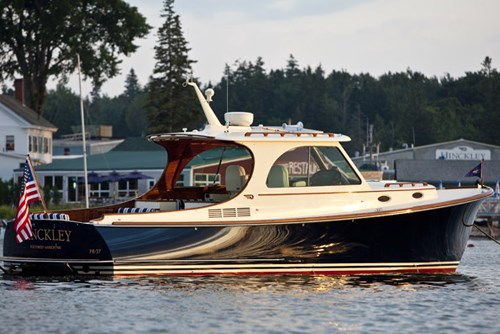Celebrating a great composite design
The well-liked and well-known Hinckley "Picnic Boat" is 20 years old. CW recounts composites use on this popular yacht.

Video: What Makes a Hinckley a Hinckley
The Wall Street Journal’s May 23 issue featured a new book by Nick Voulgaris (published by Rizzoli) entitled “Hinckley Yachts,” which celebrates with photos the boatbuilder’s long history — since 1928 — of constructing practical yet beautiful motor yachts and sailboats (now headquartered in Portsmouth, R.I., USA).
The book’s release coincides with the 20th anniversary of the introduction of the Hinckley “Picnic Boat,” a huge success for the company and a standout example of composites design and construction. Since 1994, nearly 450 copies have been produced and sold. What made it so great? The original 36-ft long, infused Kevlar/E-glass craft, equipped with a cabin, galley and head, had a draft of just 18 inches and was powered by a highly maneuverable yet quiet “jet drive,” that is, a propeller-less engine that achieves propulsion by drawing water into a pump and expelling it in a powerful “jet” (diesel power was also an option) without much noise. The very light hull weight plus very small draft enabled boaters to cruise and explore shallow water, and the durable Kevlar outer skin meant the boat could be safely beached for shore excursions.
Peter Smith, Hinckley’s senior product engineer, recalls that the original Picnic Boat was “wildly successful,” beyond anything the company imagined. “We originally thought maybe 10 to 15 boats per year, but then the orders started pouring in.” Hinckley still makes the Picnic Boat, now designated as the MKIII. Smith also confirms that Hinckley was a composites pioneer, first laying up fiberglass sailboat hulls in 1960: “We were looking to reduce weight and were introduced by DuPont [Wilmington, Del.] to a woven Kevlar/E-glass fabric that we started using as the skin over a foam core for our hulls.” That material, combined with resin impregnators and later, the trademarked SCRIMP infusion method, helped achieve much lighter hull weight with comparable properties, which in turn meant lighter propulsion equipment and better fuel mileage.
“All of our boats are composite,” adds Smith, who says that the more recent Picnic Boat model hulls use a carbon fiber inner skin, for even more weight reduction. The company’s long history, and ongoing recognition in the media, bode well for continued boatbuilding success.
Related Content
-
From the CW Archives: Airbus A400M cargo door
The inaugural CW From the Archives revisits Sara Black’s 2007 story on out-of-autoclave infusion used to fabricate the massive composite upper cargo door for the Airbus A400M military airlifter.
-
Materials & Processes: Tooling for composites
Composite parts are formed in molds, also known as tools. Tools can be made from virtually any material. The material type, shape and complexity depend upon the part and length of production run. Here's a short summary of the issues involved in electing and making tools.
-
Composite resins price change report
CW’s running summary of resin price change announcements from major material suppliers that serve the composites manufacturing industry.













